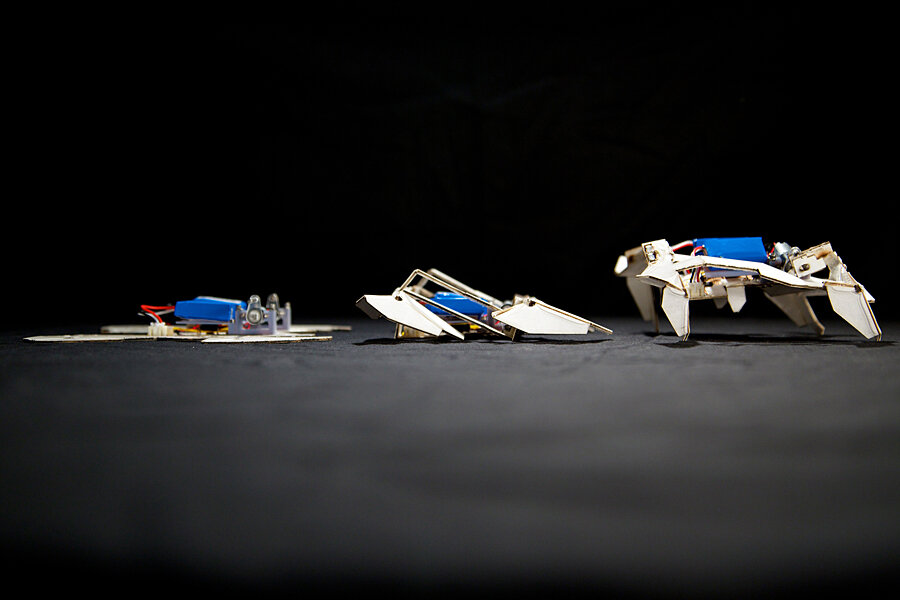How robots could assemble themselves à la origami – and not cost too much
Loading...
If you're up for an origami challenge, try this: Turn sheets of paper into a four-legged robot that scoots across the table – after it's finished performing a push-up as it folds itself into the required shapes.
In effect, a team of researchers from Harvard University and the Massachusetts Institute of Technology (MIT) has done just that. The team's origami robot draws on several developments in materials science and engineering to produce a self-assembling robot that folds itself from a two-dimensional to three-dimensional object and then performs work – in this case, scampering like a soldier crab across a tabletop.
The project is described in a research paper to be published Friday in the journal Science. It is part of a longer-term effort that the team is undertaking to find ways to dramatically cut the cost of developing and building robots.
One scenario for this approach leads to low-cost robots that can be shipped flat to a work site and then triggered to assemble themselves for search-and-rescue duties or to reconnoiter areas that would expose humans to hazardous conditions.
In principle, the approach that the team is developing also could lead to neighborhood robot boutiques. A customer requests a robot that will perform a specific function, the boutique uses special software to design the machine, and then it uses a more sophisticated version of the team's "2-D into 3-D" approach to produce a finished 'bot available for pickup the next day.
The price tag? Perhaps a few tens of dollars to a few hundred, depending on the tasks the robot would perform.
This "would really democratize access to robots," says Daniela Rus, who heads the Computer Science and Artificial Intelligence Laboratory at MIT in Cambridge, Mass., and is a member of the team that produced the origami robot.
Democratization could eventually lead into individual homes, suggests Yong-Lae Park, an assistant professor of robotics at Carnegie Mellon University in Pittsburgh.
"Traditionally, robots were considered complicated devices," something that only people with highly specialized skills could make, he says.
The origami approach could radially change that. Just as origami books can provide patterns that the purchaser can try at home, websites could provide robot templates to use with a 3-D printer or laser cutter at home. Once the pattern is cut, the robot assembles itself.
"Even though you don't have a lot of knowledge or a specialty in robotics or mechanical design, you can build your own robots at home easily," Professor Park says.
"This is really great work and a clever idea," he says of the Harvard-MIT team's approach.
In addition, the approach could enable robot-makers to quickly build and modify prototypes or change product lines without the time and expense of retooling assembly lines.
Software already is widely available to design intricate origami shapes that can turn a sheet of material into any 3-D structure desired, says MIT computer scientist Erik Demaine, another member of the team.
This, plus the application of a 137-year-old mathematical theorem describing mechanical linkages, has helped open the door to the approach the team used, he says.
The team built its robot from a thin printed circuit board sandwiched between two thick sheets of paper. This sandwich was itself sandwiched between two sheets of shape-retaining polystyrene – similar to sheets of Shrinky Dinks found in toy stores. The polystyrene contracts when heated, then retains its new shape when it cools. The paper provided the robot's structure, while the polystyrene sheets made permanent the folds in the paper that shaped each part of the robot.
Using a laser cutter, the team carefully introduced slits and gaps in the paper and polystyrene sheets. These served as hinge points for folding as well as active hinges that the legs would need for scampering.
Folding was controlled by a microprocessor, which along with batteries and two motors, was added by hand while the layered sheet lay flat. This composite was embedded with wires at the folding points that heated when electricity passed through them. Some 10 seconds after the battery was connected, the microprocessor directed heat to the wires based on the folding sequence that the team programmed in. Each fold had to cool before the next hinge was heated.
It took about two hours to make the composite and add the batteries and motors. Once activated, the robot took about 4-1/2 minutes to rise Transformers-like, from something akin to Flat Stanley to its crablike shape, and begin its scamper.
The components for the robot cost about $100, $80 of which went to the battery and motors, says Sam Felton, a doctoral candidate at Harvard's Microrobotics Laboratory in Cambridge, Mass., and the lead author of the Science paper unveiling the results.
The team built three of these prototypes. Only one assembled itself and passed the scamper test. In each of the other two, a single hinge failed to fold properly. Taken in total, 82 of 84 hinges worked as designed.
Although the motors and battery were installed by hand, other labs have developed batteries made using 3-D printing, which eventually should be able to produce motors as well, Mr. Felton notes. Thus the whole assembly – from the cutting of the circuit board, polystyrene, and paper sheets to the last origami fold – could be performed autonomously.
The size of the robots that this approach could produce is limited only by the properties of the materials and the finest scale that the laser-cutting tool can achieve.
Beyond the ability to make search-and-rescue 'bots or robotic cat toys in 24 hours, the promise of a low-cost approach to building robots could also spur high-tech education in developing countries, Dr. Rus notes.
Her team's entry won this year's challenge by the African Robotics Network to produce a working robot that costs $20 or less to produce. The team's entry used the idea of foldable robots. The African Robotics Network is based in Accra, Ghana.






